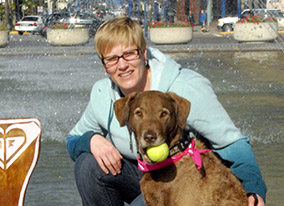You know your dog “knows it”, right? They know what you want them to do. So you stand there waiting and they don’t do it. Why? Why won’t they heel or stand, or retrieve, when you have seen them do that behavior before? Ahhhhhh, the great quest in dog training, behavior momentum!! That is the response strength of that behavior. The stronger a behavior is, the less it will change when put under pressure. So, if you have very strong behavior and you put it in a new context/environment, you should see that behavior remain strong, if it immediately weakens, then your momentum doesn’t have much strength.
How can we apply that to our training? Here is a common scenario, a trainer is teaching a dog to heel, the heeling behavior is coming along nicely in their training building or yard, and they have 10 nice steps of heeling in this familiar place. Now they go to a match, lots of change, lots of pressure on that behavior, so how reliable would that behavior be? Probably not very reliable, right? If you have 10 steps in a familiar environment, then if you got 2 a new environment you would be doing well. Now take that same trainer, they have nice heeling in their building/yard for 1 full minute, and in that same yard they have added some changes, some proofing, say heeling around toys, food distractions and other dogs. For 1 min. that dog can heel under pressure in their familiar surroundings. So, now that trainer goes to a match and how do you think the heeling would hold up? Probably pretty well! The dog has a long history (it takes a lot of history of reinforcement to get 1 min. of nice heeling!), of reinforcement and even has been proofed and shown how to work through distractions, so at a match or trial, that heeling looks good.
Behavior momentum has to do with the reinforcement history that is behind a behavior. The stronger the behavior momentum, the longer that behavior will continue under adverse factors like lack of reinforcement, environmental distractions and other things that affect that animal. So, we see that “getting” a behavior is just the start. Now we have to put many reinforcements on that behavior, making the animal love it and want to do it. A factor to consider is how hard the behavior is for the animal to do, how “expensive” as Bob Bailey would say, is it for a dog to heel vs. do a sit/stay? Most dogs have good stays long before they have good heeling, heeling is an “expensive” behavior, requiring a lot of effort from the dog and attention to owner over an extended period of time. It would take longer to get mass on a heel behavior, and would take more reinforcements, than say getting strength on a stay behavior.
Parvene Farhoody used the analogy of a bowling ball vs. a whiffle ball, which one has more mass (for us that would be #of reinforcements on the history of the behavior)? A bowling ball is dense, a whiffle ball is light, with many holes in it. If you went to the top of a hill and started rolling both downhill, which one is the most resistant to change in its path? Which one will be the most affected by the environment, things like wind, terrain and length of the hill? The bowling ball has more mass, the bowling ball will have the most momentum. I thought that was a wonderful way of thinking of your training, we want the bowling ball!
So, what to do? When do you know that your animal is getting behavioral momentum on a behavior? It’s when you see them perform the behavior without struggle. You see good speed, intensity, and persistence of that behavior, first in a very familiar area, then in that area with some change and then finally in new areas and new areas with some change (proofs).
The next time you train, think about what you are doing, are you building behavior momentum? Are you testing to see what you have? Are you proofing to make sure a behavior is strong under pressure? This is important in your training plan! You cannot effectively proof a behavior that does not have good momentum, or reinforcement history! A huge test of this is if your animal fails at something, and you stop and start the animal again, do you get the behavior you want? Your animal should try harder if you have good momentum, if you see that the animal struggles or quits, than you are lacking in the strength of that behavior, the momentum, to carry you through. Take time to go back and build it up! Don’t always make the training harder; make the animal think that what you are asking of it is the best thing in the world!!
So, a good training plan:
- Gets the behavior you want
- Puts that behavior on cue
- Builds a reinforcement history on that behavior (behavior momentum)
- Puts pressure on that behavior and makes sure that the reward rate stays high (proofing)
- Generalizes that behavior to new places (also proofing).
This subject has been on my mind a lot, I just got back from a Bob Bailey-Parvene Farhoody workshop on criteria. Here we push our chickens that we train to constantly do more, go farther and faster. Bob has set up some specific tasks that test our ability to decide and maintain criteria in training. So, of course we all want to do these tasks as soon as possible, graduate that bird. BUT, because the tasks have to have some duration to them, you have to have behavior strong enough to withstand a test that has no reinforcement available.
Task 1: The bird has to do a figure 8 twice around yellow cones placed the length of the table.
Task 2: Once the bird has passed that test, you must now teach it that if the cones are blue, they are to loop around the outside only, never performing the fig. 8 behavior.
Task 3: The bird has to change their behavior according to the color of the cones. So, if the bird turns around to make a loop and sees the cone is blue, it is to loop around the outside of the cone, and if it turns around and sees the cone is yellow, it is to do a figure 8 behavior.
To pass the test the bird must switch back and forth between the choices at least 4 times to show a true understanding of the task.
If you had asked me on day one if I could do that, I would have said no way. Then I started to truly understand behavior momentum, if I build momentum on those behaviors, I don’t need to actually test that bird on the final 4 changes much, the bird will have the history of all my good reinforcements to carry it through!!! An “AHA” moment for sure!
Here’s the video of my bird switching tasks, thank you Bob and Parvene for your awesome explanation of behavior momentum and its application to animal training!!



No comments yet.